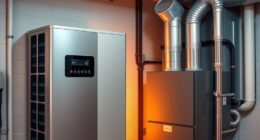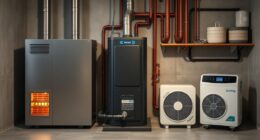The environmental impact of heat pump refrigerants depends on the type of refrigerant used and how well leaks are managed. Older refrigerants like R-22 caused ozone depletion and had high global warming potential (GWP). Switching to low-GWP options like R-32 or natural refrigerants reduces these impacts considerably. Proper containment, leak detection, and regulatory measures also matter. To find out how advancements and eco-friendly options are shaping the future, continue exploring this topic.
Key Takeaways
- Refrigerants with high GWP, like R-410A, significantly contribute to global warming if leaked into the atmosphere.
- Transitioning to low-GWP refrigerants such as R-32 and natural options reduces the environmental footprint of heat pumps.
- Regular leak detection and maintenance are essential to prevent environmental damage caused by refrigerant emissions.
- International regulations like the Kigali Amendment promote the adoption of eco-friendly refrigerants, influencing heat pump design and refrigerant choices.
- Using environmentally optimized refrigerants in heat pumps can lower household emissions and support climate change mitigation.
How Heat Pumps Contribute to Reducing Greenhouse Gas Emissions
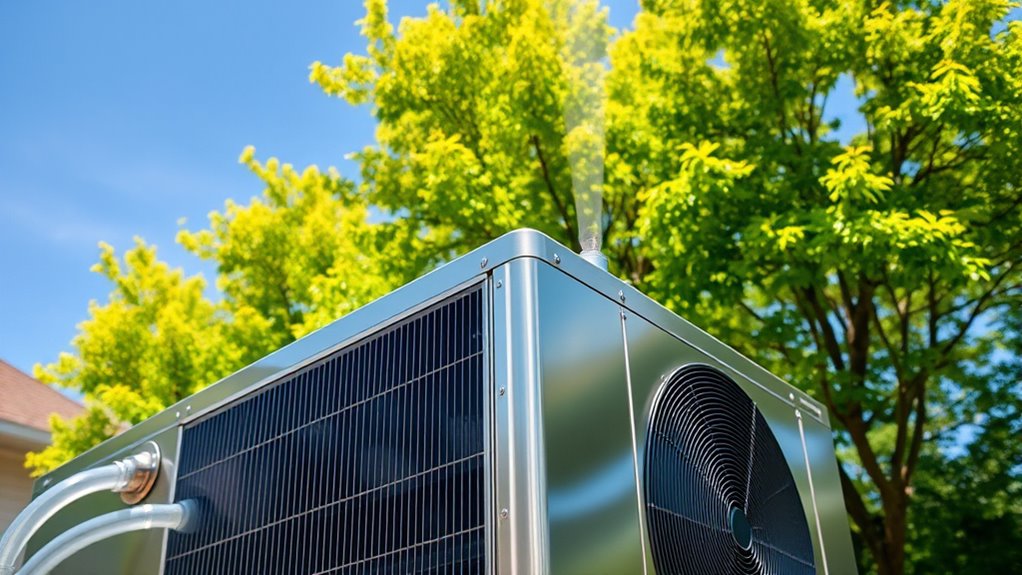
Heat pumps help cut greenhouse gas emissions by replacing traditional fossil fuel-based heating systems. They use refrigerants like R-410a, which, despite their high GWP, are less harmful than older refrigerants that deplete the ozone layer. By shifting to heat pumps, you reduce direct emissions from burning gas or oil, contributing to climate benefits. When refrigerant leakage occurs, it can release greenhouse gases, but advances in technology and regulations aim to minimize this risk. Overall, heat pumps considerably lower emissions—by over 38% compared to gas furnaces—especially when paired with renewable electricity. This changeover helps meet climate goals by decreasing reliance on fossil fuels and reducing the greenhouse gases that accelerate climate change. Your choice of heat pump supports a cleaner, greener environment. Additionally, upgrading to more efficient heat pump systems can optimize energy use and further reduce environmental impacts, supporting the transition to sustainable renewable energy sources. Incorporating advanced refrigerants with low GWP is also crucial for the future of environmentally friendly heat pump technology. The development of refrigerant management systems is essential to prevent leaks and ensure environmental safety, thereby preventing potential environmental harm. Innovations in refrigerant technology continue to improve the safety and sustainability of heat pump systems.
The Role of Refrigerants in Heat Pump Environmental Impact

Refrigerants play a vital role in your heat pump’s environmental impact, especially considering their global warming potential (GWP). Leaks can release powerful greenhouse gases that far exceed CO₂’s warming effect, making containment essential. By choosing low-GWP refrigerants and implementing leak prevention measures, you can markedly reduce your system’s environmental footprint. Additionally, understanding the types of projectors used in home systems can help optimize energy efficiency and reduce overall environmental impact. Employing advanced detection techniques can further prevent leaks and minimize greenhouse gas emissions. Regular maintenance and leak detection systems are crucial for ensuring refrigerant integrity and minimizing environmental harm. Proper refrigerant management also involves selecting systems with environmentally friendly refrigerants to further lessen ecological impact. Recognizing the importance of inspirational quotes about fatherhood can inspire responsible practices that protect our environment for future generations.
Refrigerant GWP Impact
Refrigerant Global Warming Potential (GWP) plays a vital role in determining the environmental impact of heat pump systems. High-GWP refrigerants like R-410A, with a GWP of 4,260, can release thousands of times more greenhouse gases than CO₂ during leaks, significantly adding to climate change. Consider these points:
- R-410A’s high GWP makes even small leaks a major concern for environmental impact.
- Replacing high-GWP refrigerants with low-GWP options like R-32 and R-454b helps reduce greenhouse gases released.
- Historically used refrigerants like R-22 caused ozone depletion and had GWPs over 1,800, now phased out.
- Moving to low-GWP refrigerants is essential for minimizing heat pump leaks’ climate effects and meeting regulations.
- The development of more robust safety measures is crucial to prevent leaks and minimize environmental damage.
Leak Prevention Strategies
Effective leak prevention is essential in minimizing the environmental impact of heat pump systems. Regular maintenance and leak detection help catch refrigerant leaks early, reducing emissions and environmental harm. Using advanced sealing technologies and high-quality components during installation ensures refrigerant stays contained over the system’s lifespan. Moving to low-GWP refrigerants such as R-32 and R-454b further decreases potential environmental damage caused by leaks. Implementing proper refrigerant recovery and disposal practices at the end of equipment life prevents atmospheric emissions. Industry standards like EPA Section 608 and certifications like NATE promote best practices for leak prevention and leak detection. Additionally, selecting vetted refrigerants that have been evaluated for environmental safety can further minimize ecological risks. Staying informed about refrigerant regulations and compliance requirements helps ensure ongoing adherence to environmentally friendly practices. By prioritizing these strategies, you can markedly reduce refrigerant leaks, safeguarding the environment while maintaining system efficiency.
Evolution of Refrigerant Types and Their Global Warming Potential

You’ve seen how refrigerants evolved from ozone-depleting CFCs to more environmentally friendly options. Today, low-GWP refrigerants like R-32 and R-454B are replacing high-GWP HFCs, with ongoing innovations aiming for even lower climate impacts. The global push, including the Kigali Amendment, encourages continuous development toward refrigerants that markedly reduce warming potential. Proper storage conditions of refrigerants can also influence their environmental impact over time. Additionally, advancements in refrigerant formulation are being pursued to further minimize their global warming potential and environmental footprint. Continued regulatory efforts are essential to support the adoption of these eco-friendly refrigerants worldwide.
Transition From CFCS to HFCS
The shift from chlorofluorocarbons (CFCs) to hydrofluorocarbons (HFCs) represents a significant step in reducing the environmental impact of refrigerants. This changeover eliminated substances responsible for ozone depletion, improving air quality worldwide. Here are four key points:
- CFCs, once common in refrigerants, caused severe ozone layer damage and had high global warming potential (GWP).
- HFCs replaced CFCs because they don’t harm the ozone layer, but some, like R-410A, have GWPs over 4,260 times that of CO₂.
- The move away from CFCs marked progress but still left climate concerns due to HFCs’ high GWP. Environmental impact continues to be a concern as new alternatives are developed.
- International efforts now focus on phasing down HFCs, encouraging low-GWP refrigerants to mitigate climate change. Additionally, ongoing research aims to develop sustainable refrigerants that offer low GWPs and high efficiency.
- Advancements in refrigerant technology continue to seek environmentally friendly solutions with lower GWPs, promoting sustainable heating and cooling options. Furthermore, the development of natural refrigerants like propane and isobutane is gaining momentum due to their minimal environmental footprint. These innovations are crucial for addressing the climate impact of traditional refrigerants and ensuring a greener future.
Development of Low-GWP Refrigerants
As concerns about climate change grow, the development of low-GWP refrigerants has become a top priority in the heat pump industry. Advances in refrigerant chemistry enable the creation of low-GWP refrigerants that reduce environmental impact without sacrificing performance. Early refrigerants like R-12 and R-22 caused ozone depletion and had high GWP, leading to their phased-out status, starting with R-22 in 2020. Modern systems mainly use R-410A, with a GWP over 2,000, prompting efforts to develop alternatives like R-32 and R-454B, which offer markedly lower GWP. These innovations are driven by international agreements such as the Kigali Amendment and evolving regulations. The goal is to balance environmental impact, safety, and efficiency in refrigerant development, ensuring sustainable heat pump operations. Environmental regulations continue to shape the development and adoption of new refrigerant technologies worldwide. Additionally, research into refrigerant safety and compatibility is vital to ensure these new substances can be widely implemented without unforeseen risks. Furthermore, ongoing refrigerant testing is essential to verify performance and environmental benefits before large-scale adoption. Incorporating innovative testing methods can accelerate the validation process and improve safety standards. Staying informed about industry advancements can help stakeholders adapt to new standards and improve overall system design.
Future Refrigerant Innovations
Future refrigerant innovations are poised to transform heat pump technology by introducing types with substantially lower global warming potential. Advances in refrigerant chemistry focus on developing natural refrigerants, like hydrocarbons such as propane, with ultra-low GWP. Industry efforts aim to create refrigerants that meet evolving regulatory standards, including the Kigali Amendment and AIM Act, which prioritize GWP reduction. Here’s what you should expect:
- Increased adoption of natural refrigerants with minimal environmental impact.
- Development of ultra-low GWP refrigerants that maintain high efficiency.
- Regulatory pressures driving the phase-out of high-GWP options like R-410A.
- Innovative solutions balancing climate safety with compliance, reshaping refrigerant chemistry for a sustainable future. These advancements will ensure heat pump systems become even more environmentally friendly while adhering to global standards.
Additionally, ongoing research into refrigerant lifecycle management aims to reduce environmental footprints throughout the entire lifespan of refrigerants, further supporting sustainable heating and cooling solutions. Moreover, innovations in refrigerant containment are crucial for minimizing leaks and maximizing system efficiency, contributing to overall environmental benefits.
Managing Refrigerant Leaks: Risks and Best Practices

Managing refrigerant leaks effectively is crucial to minimizing environmental harm from heat pump systems. Leaks, which average around 3% annually, release greenhouse gases that worsen climate change. To prevent this, implement regular leak detection with ultrasonic sensors or dye tests, allowing early identification. When leaks occur, refrigerant recovery ensures proper disposal, adhering to regulations that prohibit venting R-410A into the atmosphere. Prioritizing low-GWP refrigerants reduces long-term environmental impact.
| Issue | Solution | Benefit |
|---|---|---|
| Refrigerant leaks | Leak detection & maintenance | Minimize emissions |
| Environmental impact | Refrigerant recovery | Prevent pollution |
| Leak prevention | Use durable, low-GWP refrigerants | Reduce future risks |
| Regulatory compliance | Professional recovery services | Avoid penalties |
Regulatory Changes and Future Trends in Refrigerant Use
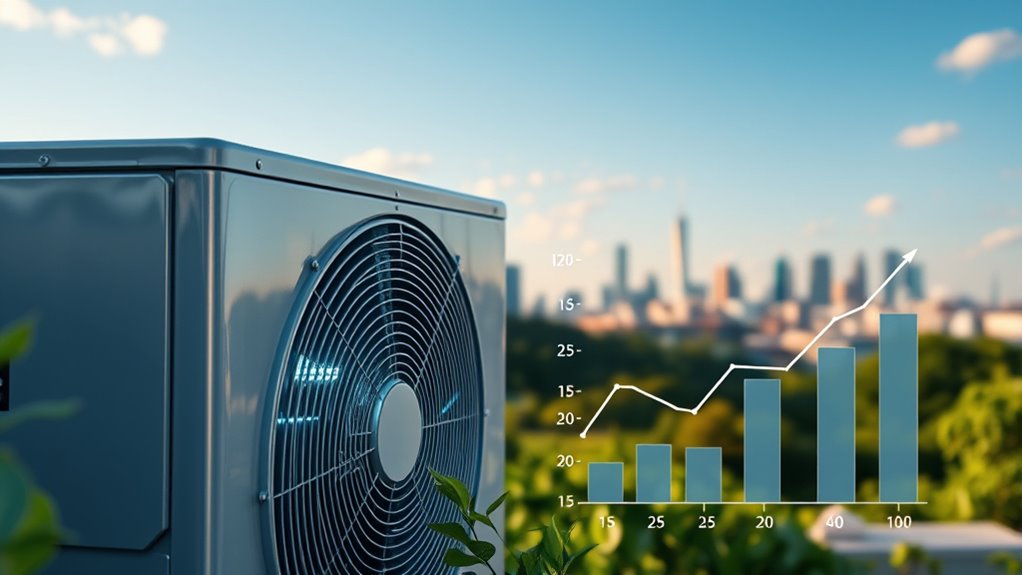
Regulatory changes are shaping the landscape of refrigerant use in heat pump systems, driven by increasing concerns over environmental impact. The AIM Act of December 2020 mandates an 85% reduction in HFC production over 15 years, accelerating phase-out policies for high-GWP refrigerants. Expect the EPA to implement regulations that restrict HFC use where alternatives exist and require refrigerant recovery from existing systems. States like California are pushing policies to minimize HFC leaks and promote low-GWP refrigerants. As high-GWP refrigerants such as R-410A become more expensive, industry shifts toward environmentally friendly options are accelerating. Future refrigerant standards aim to foster the development of low-GWP, climate-safe refrigerants, reducing the environmental impact of heat pump systems.
Comparing Heat Pump Environmental Benefits With Traditional Heating Methods

Heat pumps offer a markedly more environmentally friendly alternative to traditional heating methods, such as gas furnaces and resistance electric heating. They use refrigerants that have lower global warming potential and produce fewer greenhouse gases, especially when using low-GWP options like R-32 or R-454b. Compared to gas furnaces, heat pumps can cut household CO2 emissions by over 50%, reducing annual emissions from around 8,000 lbs to about 4,950 lbs. They are also 2-3 times more energy efficient than resistance electric systems, meaning less electricity consumption and fewer emissions overall. While traditional refrigerants like R-22 had high GWP values and harmed the environment, modern refrigerants used in heat pumps provide significant environmental benefits without damaging the ozone layer.
Strategies for Minimizing Refrigerant Impact in Heat Pump Systems
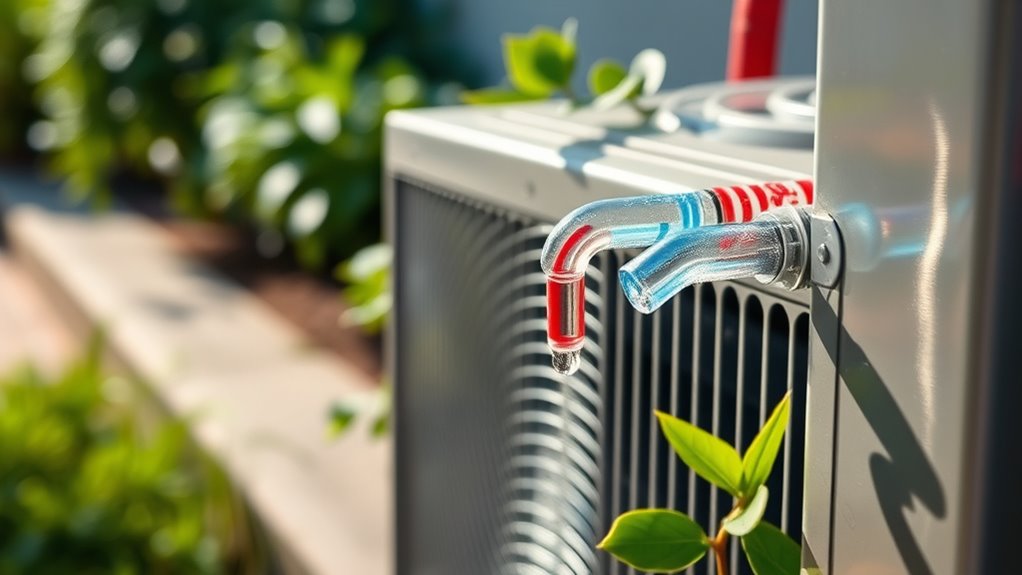
To minimize the environmental impact of refrigerants in heat pump systems, adopting proactive strategies is essential. First, prioritize regular maintenance and leak detection to catch refrigerant leaks early, preventing harmful releases. Second, choose low-GWP refrigerants like R-32 or R-454b, which have lower global warming potentials. Third, ensure proper system design and installation by certified technicians to optimize system efficiency and reduce refrigerant loss. Fourth, incorporate refrigerant recycling and recovery practices during servicing and disposal to prevent atmospheric emissions. Additionally, advocate for compliance with regulations that limit leak rates and promote environmentally friendly refrigerants. These strategies help protect the environment while maintaining system performance and efficiency.
Frequently Asked Questions
Are Heat Pumps Bad for the Environment?
You might wonder if heat pumps harm the environment. While they use refrigerants with high global warming potential, they generally offer better environmental benefits than fossil fuel systems. Proper installation, maintenance, and using low-GWP refrigerants can considerably reduce their impact. When you choose and care for a heat pump responsibly, it can be an eco-friendly option that helps lower your carbon footprint.
Is Heat Pump Refrigerant Toxic?
You might wonder if heat pump refrigerants are toxic. In reality, modern refrigerants like R-410A and R-32 are designed to be non-toxic and chemically inert, making them safe under normal use. While older types like R-22 posed health risks if leaked, they’re mostly phased out. As long as you handle and maintain your system properly, the refrigerants in today’s heat pumps won’t harm you or the environment.
What Are the Environmental Impacts of Refrigerants?
You should understand that refrigerants impact the environment mainly through their potential to cause ozone depletion and global warming. Older refrigerants like R-22 damage the ozone layer, while newer ones such as R-410A and R-32 have higher GWPs, contributing to climate change if leaked. By properly managing and preventing leaks, you can reduce these impacts and make heat pumps more environmentally friendly.
What Is the Carbon Footprint of a Heat Pump?
Think of your heat pump as a quiet, efficient engine humming in the background, transforming electricity into warmth. Its carbon footprint depends on the energy source—renewables make it nearly zero, while fossil fuels add more emissions. Leaking refrigerants release potent greenhouse gases, increasing its impact. With high efficiency and clean energy, you can profoundly lower your carbon footprint, helping the planet stay cooler and healthier.
Conclusion
By choosing modern heat pump refrigerants wisely, you can markedly cut greenhouse gases, much like pruning a tree to promote healthier growth. Staying informed about evolving regulations and best practices lets you minimize leaks and environmental impact. Ultimately, your actions can turn your heating system into a champion for sustainability, helping the planet breathe easier—just as a gentle breeze clears away storm clouds. Every conscious choice makes a difference in safeguarding our shared environment.






